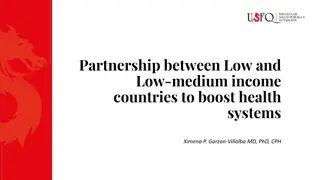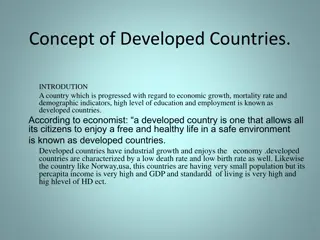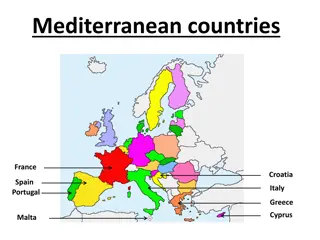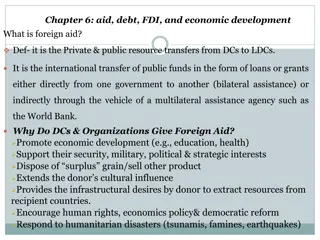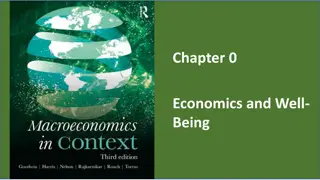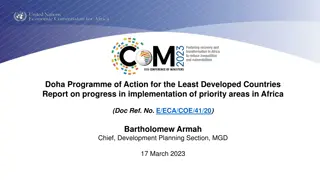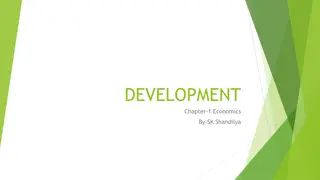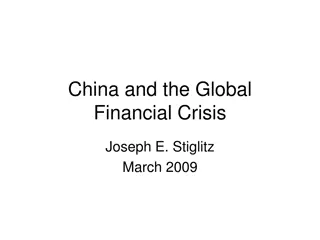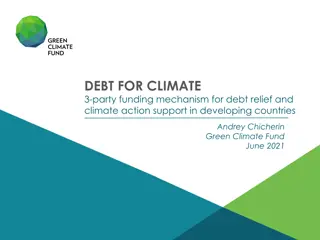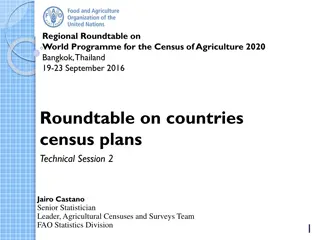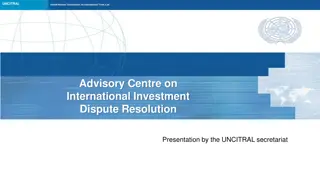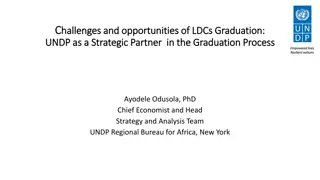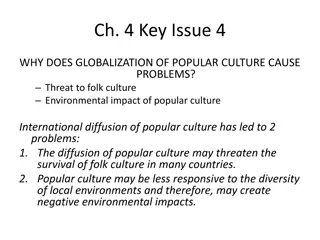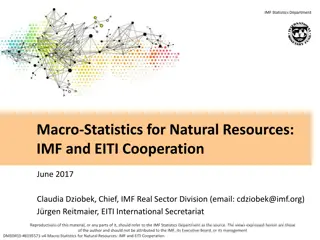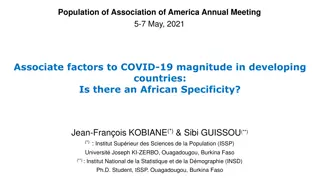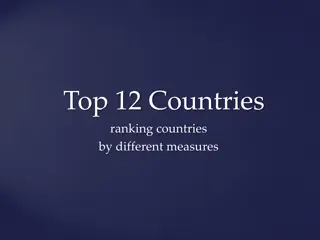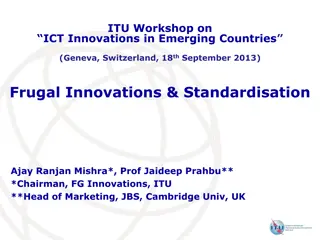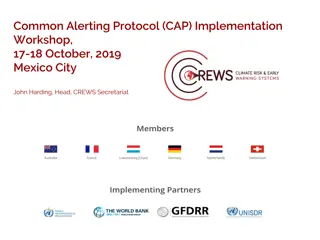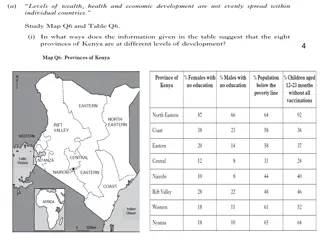Understanding Globalization's Impact on Developing Countries
Economic globalization, characterized by increased integration of economies, presents both opportunities and challenges for developing nations. While it offers benefits like knowledge transfer and trade growth, it can also exacerbate inequalities and environmental degradation. Globalization raises q
6 views • 52 slides
Geospatial Comparison of Economic Change and Climate Disasters in Asia-Pacific
This study explores the impact of natural disasters on economic indicators in Southern and Western Asian countries over time, aiming to assist in policy-making by understanding the relationship between natural disasters and the economy. It discusses the increasing incidences of extreme weather event
4 views • 18 slides
Physician Satisfaction Levels in High-Income Countries
Primary care physicians' satisfaction with their medical practices, income, quality of care, and time spent with patients varies across high-income countries. Sweden, France, and Switzerland stand out for higher overall satisfaction levels, while concerns over quality of care since the COVID-19 pand
4 views • 7 slides
Partnership between Low and Low-medium income countries to boost health. systems
This presentation highlights the common challenges faced by low and low-medium income countries in boosting their health systems, such as political instability, lack of funding, and unstructured healthcare systems. It emphasizes the importance of collaborative efforts between these countries to addr
6 views • 6 slides
Exploring Nordic and European Countries Through Maps
Discover the beauty and diversity of Nordic and European countries through a series of detailed maps showcasing countries like Greenland, Finland, Norway, Sweden, Iceland, and many others. From the stunning landscapes of Scandinavia to the rich cultural heritage of Central Europe, these maps offer a
2 views • 13 slides
Contrasting Characteristics of Developed and Developing Countries
Developed countries are characterized by high per capita income, strong GDP growth, and advanced standards of living, while developing countries exhibit lower income levels, high population growth, and challenges in technology and infrastructure. The differences extend to economic, demographic, tech
1 views • 7 slides
Overview of Mediterranean Countries in the European Union
France, Italy, and Greece are prominent Mediterranean countries in the European Union, each with unique attributes. France stands out with its semi-presidential republic system, Italy with its parliamentary republic, and Greece with its rich historical background. These countries have been EU member
0 views • 25 slides
Understanding the Vulnerability Index for Small Island Developing States
This article discusses the concept of vulnerability in the context of countries, focusing on Small Island Developing States (SIDS). It explores the differences between vulnerability and poverty, the history of vulnerability index development from SIDS to Least Developed Countries (LDCs), and critiqu
8 views • 44 slides
Winners and Losers in the First Globalization
The First Globalization led to the rise of wealthier countries while less developed nations faced challenges in international trade, widening the economic gap. The Heckscher-Ohlin model explains the benefits of specialization and trade by focusing on productive factor endowments. Countries leverage
0 views • 29 slides
Understanding Foreign Aid, Debt, FDI, and Economic Development
Foreign aid refers to the transfer of resources from developed countries to less developed countries to promote economic development, support security interests, and address humanitarian needs. Donors give aid for political and economic reasons, with foreign exchange constraints playing a significan
1 views • 31 slides
Erasmus+ Programme 2021-2027: International Credit Mobility Updates
The Erasmus+ Programme for 2021-2027 introduces novelties in International Credit Mobility (ICM) including changes in funding allocation, participant profiles, application processes, and budget distribution across regions. These updates aim to enhance flexibility, streamline budget management, and p
0 views • 14 slides
International Economic Indicators Comparison
The data presented includes GDP per capita rankings for various countries in 2015, showcasing the economic status of nations like Qatar, Norway, and the United States. It also illustrates the growth in GDP per capita from 2006 to 2015, with countries like China and India showing significant progress
2 views • 21 slides
Understanding the CAGE Distance Framework for International Business
The CAGE Distance Framework, developed by Pankaj Ghemawat, helps companies assess Cultural, Administrative, Geographic, and Economic distances between countries when crafting international strategies. By considering these factors, businesses can identify implications for their strategy and project.
0 views • 4 slides
Peer Learning and Exchange: Advancing Gender-Responsive Climate Budgeting
Countries recently converged to discuss integrating gender and climate change into national planning and budgeting. With 16 countries and 82 government officials participating, there was a focus on gender-responsive budgeting experiences and the emerging field of gender-responsive climate budgeting.
1 views • 5 slides
Progress in Implementing Priority Areas for Least Developed Countries in Africa
The report highlights progress in key areas for the Least Developed Countries (LDCs) in Africa. It discusses status towards graduation, investing in people, leveraging science, technology, and innovation, and challenges such as undernourishment, unemployment, and limited access to clean water and in
0 views • 10 slides
Overview of Development Economics and Goals
Development economics is a branch of economics that focuses on improving the economies of developing countries by targeting factors such as health, education, working conditions, and policies. It involves macroeconomic and microeconomic analysis to enhance domestic and international growth. Differen
1 views • 11 slides
The Global Financial Crisis: Impact on China and the Global Economy
The global financial crisis described by Joseph E. Stiglitz in March 2009 highlights the interconnectedness of economies and the challenges faced by various countries. The crisis has led to a deep and prolonged downturn affecting both developed and developing nations, debunking the myth of decouplin
0 views • 33 slides
Global Economic Update: High-income Economies Accelerating, Developing Countries Facing Challenges
The global economic outlook presents a contrast between high-income economies accelerating in growth while developing countries encounter challenges due to headwinds and capacity constraints. Key messages highlight the need for structural reforms to enhance outcomes. Risks include fallout from the s
4 views • 34 slides
Small Countries' Resilience Against Center-Country Monetary Policies
Small countries should not fear the monetary and financial policies of larger center countries. This article discusses the potential spillovers of unconventional monetary policies by center countries, such as quantitative easing and negative nominal interest rates. It explores the concept of currenc
0 views • 39 slides
Understanding Chronic Diarrhea: Causes and Consequences
Chronic diarrhea is characterized by persistent loose, watery stools lasting more than 14 days. The condition can be caused by various factors such as osmotic, secretory, inflammatory, or motility disorders. In developing countries, it often follows acute infections, while in developed countries, un
0 views • 71 slides
Three-Party Funding Mechanism for Debt Relief and Climate Action Support in Developing Countries
Developing countries require significant financial support to address climate vulnerabilities, surpassing current commitments from developed nations. A suggested three-party funding mechanism aims to facilitate ongoing funding for climate projects while providing debt relief to vulnerable countries,
0 views • 11 slides
Overview of Agricultural Census Participation in Asian Countries
This text highlights the participation of Asian countries in agricultural censuses during the World Programme for the Census of Agriculture (WCA) rounds in 2010 and planned for 2020. It provides insights into the countries that conducted agricultural censuses, their respective plans for the upcoming
0 views • 14 slides
Evolution of Progressive Income Tax Systems
The concept of modern progressive income tax, developed in the early 20th century in countries like the UK, US, France, India, and Argentina, is based on the principle of a comprehensive tax base encompassing various income categories. The system involves effective vs. marginal tax rates, different
0 views • 19 slides
Regional Roundtable on World Programme for the Census of Agriculture 2020
The Regional Roundtable held in Port of Spain, Trinidad and Tobago in May 2017 focused on countries' census plans for the World Programme for the Census of Agriculture. The event discussed participation statistics, census rounds, and the status of FAO Caribbean countries in conducting agricultural c
0 views • 13 slides
Overview of Digital Switchover Plan in SATRC Countries
The study discusses the importance and necessity of Digital Switchover (DSO) in SATRC countries, highlighting the transition from analogue to digital TV and radio. It covers the global trends in digital broadcasting standards, the status of DSO in various countries like India, and the need for harmo
0 views • 16 slides
Impact of Digital Communication on Social Inequality
The impact of digital forms of communication in a global context highlights the existence of a digital divide based on social inequality, particularly regarding access to information and communication technologies. This digital gap is evident within countries like the UK, where disparities exist bet
2 views • 12 slides
International Investment Dispute Resolution Advisory Centre by UNCITRAL
The UNCITRAL Advisory Centre on International Investment Dispute Resolution aims to address the increasing number of investment disputes faced by countries, particularly developing and least developed nations. The Centre provides technical assistance, legal advice, and capacity-building to help thes
0 views • 8 slides
Comparative Study of Sales Tax on Services in Various Countries
This content provides information on the scope and implementation of sales tax on services in different countries like Pakistan, India, Australia, Canada, France, Japan, and Malaysia. It highlights the VAT/GST regimes across the globe, the number of countries implementing VAT/GST by region, and coun
0 views • 55 slides
Challenges and Opportunities of LDCs Graduation: UNDP's Role
Overview of the challenges and opportunities faced by Least Developed Countries (LDCs) in the graduation process, highlighting the criteria, countries already graduated, and those scheduled for graduation. The presentation discusses the role of UNDP as a strategic partner in supporting LDCs through
0 views • 12 slides
Challenges of Globalization in Popular Culture
Globalization of popular culture presents challenges such as the threat to folk culture and negative environmental impacts. Rising incomes lead to a shift from folk to popular culture, affecting traditional values and clothing symbolism. The adoption of Western clothing in Middle Eastern countries f
0 views • 12 slides
Bridging the Standardization Gap in ICT Development
Participation in ICT standardization processes is essential for bridging the gap between developed and developing countries. Strong standards aid in establishing technical requirements, ensuring safe and interoperable ICT equipment, and reducing the digital divide. Initiatives such as capacity build
0 views • 15 slides
Understanding State-Building Contracts in Fragile Situations
State-building contracts play a crucial role in supporting countries in fragile situations by promoting good governance, oversight, and combating corruption. These contracts, introduced in 2012 by the EU, focus on vital state functions and basic service delivery. Requirements such as stable economic
0 views • 12 slides
IMF Statistics Department - Natural Resources Statistical Tools
IMF Statistics Department has developed two statistical tools, the Revenue Template and National Accounts Template, to help countries analyze government revenues and natural resources in national accounts. These tools are crucial for policymaking in countries heavily reliant on natural resource reve
0 views • 9 slides
Factors Influencing COVID-19 Magnitude in Developing Countries: African Specificity
An exploration of factors influencing the magnitude of COVID-19 in developing countries, with a focus on any African specificity. The study uses diverse data from various developing countries to investigate the impact of demographic, economic, social service access, environmental, climatic, and heal
0 views • 16 slides
Exploring the Top 12 Countries by Size, Population, and Economy
Unveil the top 12 largest countries in the world based on various measures like size, population, and economy. Discover why some large countries are not among the most populous or economically strong. Delve into the relationship between wealth, size, and population in these countries.
0 views • 9 slides
Impact of Standardization on Economic Growth in Emerging Countries
Standardization plays a crucial role in the economic growth of emerging countries by contributing significantly to GDP growth and labor productivity. Case studies from countries like Germany, UK, Canada, and Australia highlight the positive impact of standards on innovation and overall economic perf
0 views • 8 slides
Enhancing Early Warning Systems: The CREWS Initiative in Action
The CREWS Initiative supports Least Developed Countries and Small Island Developing States in building multi-hazard early warning systems to protect lives and assets. Through workshops, training, and capacity building programs, CREWS focuses on improving service delivery, strengthening communication
0 views • 9 slides
Competition Policy and Economic Growth in Latin America
This study explores the relationship between competition policy and economic growth in Latin America, comparing indicators such as local competition intensity and effectiveness of antimonopoly policy across various countries. The findings suggest that Latin American countries lag behind developed na
0 views • 11 slides
Safflower: Overview of Cultivation, Climate, and Global Scenario
Safflower, scientifically known as Carthamus tinctorius L., is a versatile oilseed crop cultivated in various countries. The plant is characterized by its thistle-like appearance, branching structure, and cross-pollination nature. Safflower is adaptable to different climates, preferring drier areas
0 views • 29 slides
Regional Development Disparities in Kenya, India, and Other Countries
The provided content discusses the disparities in development indicators across different regions, focusing on Kenya, India, and other countries. It highlights significant differences in education, wealth, and health outcomes, showcasing how certain regions are more developed than others based on sp
0 views • 25 slides



